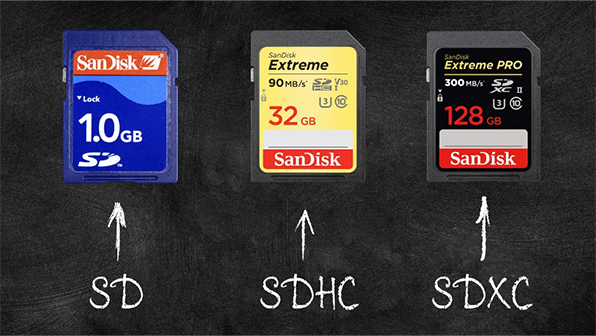
Figure 1: SD, SDHC, SDXC cards.
As a type of memory cards, Secure Digital card is referred to as SD card. It outperforms CF card and early SM card in terms of security. It is a brand-new memory card product jointly developed by Japan's Panasonic Corporation, Toshiba
Corporation and SanDisk
Corporation. The biggest feature is that it ensures the security and confidentiality of data through the encryption function.
The subtypes of SD cards include MiniSD, MicroSD, SDHC, T-Flash and SDXC, which will be introduced as follows.
MiniSD

Figure 2: Onefavor MiniSD card.
Considering that the SD card is slightly bloated for small digital products such as mobile phones, and to catch up with Duo and Xd, the SD card camp has launched a smaller memory card called "MiniSD". Its external dimensions are 20mm×21.5mm×1.4mm. The package area is 44% of the original SD card, the volume 63% of the original. MiniSD has 11 gold fingers (the SD card only has 9). It can also be used as an SD card through an adapter card. The card is widely used in mobile phones such as Dopod and Panasonic.
T-Flash Card
T-Flash card is short for TransFLash, jointly developed by Motorola and SanDisk, launched in 2004. It is an ultra-small card (11*15*1MM), only about 1/4 of a SD card, and can be regarded as the smallest memory card at present. TF card can be used as SD card with a SD card converter. The adapter can be used on devices that use SD as a storage medium.
Figure 3 presents the features of T-Flash cards.
| Developed for | Camera phones to capture large images and to be able to download larger video clips |
| Personal content | Available to store digital photos, MP3s, games and applications for mobile phones and personal data, etc. |
| New function | Encryption to protect personal data, financial records and health and medical documents |
Figure 3: Features of T-Flash cards.
MicroSD
MicroSD card was developed by SD Association in 2005 with reference to the standards of T-Flash, and is compatible with T-Flash card. Compared with MiniSD card, MicroSD card is more compact.
SDHC
SDHC is an acronym for "Secure Digital High Capacity". In May 2006, the SD Association released the latest version of the SD 2.0 system specification. It stipulates that SDHC is an SD card with a capacity greater than 2GB and less than or equal to 32GB.
The biggest feature of SDHC is its high capacity (2GB-32GB). In addition, the SD Association stipulates that SDHC must use the FAT32 file system, because the FAT16 file system previously used in SD cards supports a maximum capacity of 2GB, which cannot meet the requirements of SDHC. Figure 4 shows the specific features of SDHC cards.
| Capacity | Upto 32GB |
| File system | FAT32 |
| Speed | Speed Class: Class 2 (2MB/sec), Class4 (4MB/sec), Class6 (6MB/sec) |
| Feature | It supports real-time storage of high-resolution video recordings |
Figure 4: Features of SDHC cards.
SDXC
The SD Association showcased a 2TB SDXC memory card (SD Extended Capacity) at Consumer Electronics Show (CES) 2009. SDXC not only has a large capacity, but also excellent data transmission speed. According to reports, the maximum transmission speed is expected to reach 300MB/s.
For this large-capacity memory card, users who use Nintendo Developer’s System (NDS) flash cards or memory stick vests can store anything in it at will. However, its data security performance is not yet clear. This SDXC memory card uses NAND flash memory chips and uses Microsoft's exFAT file system (vista's new file system).
Related Info
How to Calculate the Service Life for Linear GuidewaysHow to Deal with the Abnormal Noises from the Linear Guideways?
Differences between Rolling and Sliding Linear Guideways
What is a Memory Card?
What is a Memory Stick?


